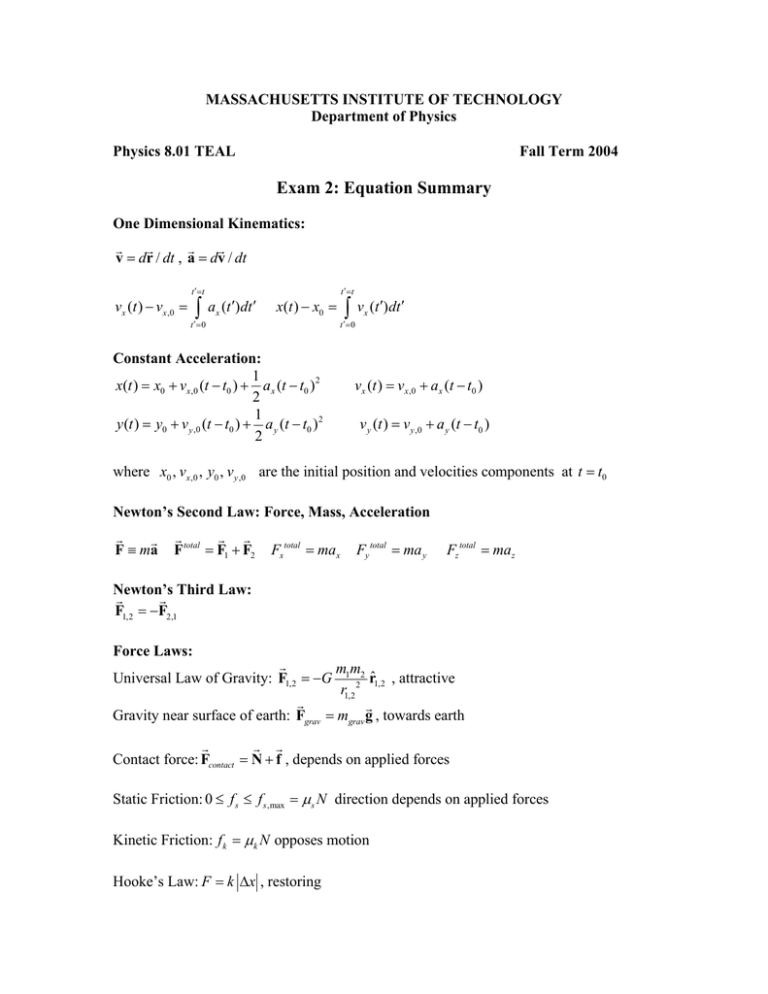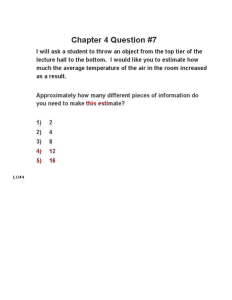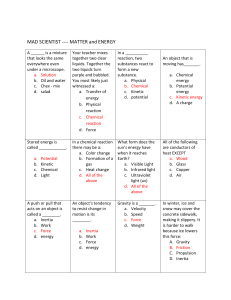Exam 2: Equation Summary
advertisement

MASSACHUSETTS INSTITUTE OF TECHNOLOGY Department of Physics Physics 8.01 TEAL Fall Term 2004 Exam 2: Equation Summary One Dimensional Kinematics: r r r r v = dr / dt , a = dv / dt t ′=t vx (t ) − vx,0 = ∫ ax (t ′)dt ′ t ′=t x(t ) − x0 = t′=0 ∫ v (t ′)dt ′ x t′=0 Constant Acceleration: 1 x(t) = x0 + vx,0 (t − t0 ) + ax (t − t0 ) 2 2 1 y (t ) = y0 + v y,0 (t − t0 ) + a y (t − t0 ) 2 2 vx (t ) = vx,0 + ax (t − t0 ) v y (t ) = v y,0 + a y (t − t0 ) where x0 , vx,0 , y0 , v y,0 are the initial position and velocities components at t = t0 Newton’s Second Law: Force, Mass, Acceleration r r F ≡ ma r r r F total = F1 + F2 Fx total = max Fy total = ma y Fz total = maz Newton’s Third Law: r r F1,2 = −F2,1 Force Laws: r mm Universal Law of Gravity: F1,2 = −G 1 22 r̂1,2 , attractive r1,2 r r Gravity near surface of earth: Fgrav = mgrav g , towards earth r r r Contact force: Fcontact = N + f , depends on applied forces Static Friction: 0 ≤ f s ≤ f s,max = µ s N direction depends on applied forces Kinetic Friction: f k = µk N opposes motion Hooke’s Law: F = k ∆x , restoring Kinematics Circular Motion: arc length: s = Rθ ; angular velocity: ω = dθ dt tangential velocity: v = Rω ; angular acceleration: α = dω dt = d 2θ dt 2 ; tangential acceleration aθ = Rα . Period: T = 2π R 2π R 2π 1 ω = = ; frequency: f = = , ω T 2π v Rω ∫ v 2 4π 2 R ; ar = 4π 2 R f 2 ; ar = 2 R T r dmr ∫ dm Radial Acceleration: ar = R ω 2 ; ar = i=N r Center of Mass: R cm = r ∑mr i i i=1 i=N ∑m → i body ; body i=1 i=N r Velocity of Center of Mass: Vcm = r ∑m v i i i=1 i=N ∑m → ∫ r dmv ∫ dm body i body i=1 r r r r r r Torque: τ S = rS ,P × FP τ S = rS ,P FP sin θ = r⊥ F = rF⊥ r r r r Static Equilibrium: Ftotal = F1 + F2 + ... = 0 ; Kinetic Energy: K = r r r r τ total = τ S ,1 + τ S ,2 + ... = 0 . S 1 2 1 1 mv ; ∆K = mv f 2 − mv0 2 2 2 2 r f r r Work: W = ∫ F ⋅ dr ; Work-Change in Kinetic Energy: W total = ∆K r0 r r Power: P = F ⋅ v = dK dt B r r Potential Energy: ∆U = −Wconservative = − ∫ Fc ⋅ dr A Potential Energy Functions with Zero Points: Constant Gravity: U ( y ) = mgy with U ( y0 = 0) = 0 . Gm1m2 Inverse Square Gravity: U gravity (r) = − with U gravity (r0 = ∞) ≡ 0 . r 1 Hooke’s Law: U spring ( x) = kx 2 with U spring ( x = 0) ≡ 0 . 2 r r r Work- Change in Mechanical Energy: Ftotal = Fc total + Fnc total ; W total = Wc total +Wnc total = ∆K ; Wnc = ∆K + ∆U total = ∆Emech , Wnc = ∆Emech = E f − E0 = ( K f +U f total ) − ( K 0 +U 0total ) Emech = K +U total MASSACHUSETTS INSTITUTE OF TECHNOLOGY Department of Physics Physics 8.01T Fall Term 2004 Practice Exam 2 Note: The Exam 2 will have a few concept questions on the test. Review all the concept tests from class to prepare for this. Problem 1: static equilibrium You are able to hold out your arm in an outstretched horizontal position thanks to the action of the deltoid muscle. Assume the humerus bone has a mass of m , the center of mass of the humerus is a distance d from the scapula, the deltoid muscle attaches to the humerus a distance a distance s from the scapula and the angle the deltoid muscle makes with the horizontal is α . A schematic representation of this action looks as follows: a) What is the tension T in the deltoid muscle? b) What are the vertical and horizontal components of the force exerted by the scapula (shoulder blade) on the humerus? Problem 2: Water Bucket A water bucket attached to a rope and spun in a vertical circle of radius r . Suppose the bucket has mass m and that the bucket can be approximated as a point mass at the end of the rope. The rope breaks when the bucket is moving vertically upwards. The bucket rises to a height h above the release point. a) What was the velocity of the bucket when it was released? \ b) What was the tension in the cord when it broke? Problem 3: spring and loop A mass m is pushed against a spring with spring constant k and held in place with a catch. The spring compresses an unknown distance x . When the catch is removed, the mass leaves the spring and slides along a frictionless circular loop of radius r . When the mass reaches the top of the loop, the force of the loop on the mass (the normal force) is equal to twice the weight of the mass. a) Using conservation of energy, find the kinetic energy at the top of the loop. Express your answer as a function of k, m, x, g, and R. b) Using Newton’s second law, derive the equation of motion for the mass when it is at the top of the loop. c) How far was the spring compressed? Problem 4: inclined plane, friction, spring An object of mass m slides down a plane which is inclined at an angle θ . The object starts out at rest a distance s from an unstretched spring that lies at the bottom of the plane. The spring has a constant k . a) Assume the incline plane is frictionless. How far will the spring compress when the mass first comes to rest? b) Now assume that the incline plane has a coefficient of kinetic friction µk . How far will the spring compress when the mass first comes to rest? c) In case b), how much energy has been lost to heat? Problem 5: elliptic orbit A satellite of mass m is in an elliptical orbit around a planet of mass m p which is located at one focus of the ellipse. The satellite has a velocity va at the distance ra when it is furthest from the planet. The distance of closest approach is rp . a) What is the magnitude of the velocity v p of the satellite when it is closest to the planet? b) If the satellite were in a circular orbit of radius rc = rp , is it’s velocity vc greater than, equal to, or less than the velocity v p of the original elliptic orbit? Justify your answer.




